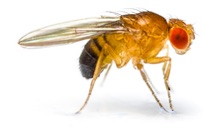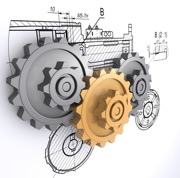 A Great Experiment should have several qualities: it should address a Big Question of its time, it should ‘move the ball’ a good ways and be universally seen to do so, it should entail an approach that is insightful and hopefully clever, and should represent a careful foundation of what system and techniques should be employed–or invented. “Mutations affecting segment number and polarity in Drosophila” by Christiane Nüsslein-Volhard and Eric Wieschaus is just such a paper. FYI, the Lasker Award folks and the Nobel Prize selection committee thought so too. It represents a combination of a huge question (where does multicellular form come from given a single-celled start?), brilliant recognition of ideal experimental system (Drosophila combines ancient genetic tools with a ‘body plan’ that is scribed on the surface of the early embryo), invention (I believe) of Drosophila ‘replica plating’ and resulted in a series of mutants that by their existence and phenotypes left us with a clear idea of how the body plan of Drosophila is laid out through sequential gene-expression driven subdivision into smaller regions. Continue reading
A Great Experiment should have several qualities: it should address a Big Question of its time, it should ‘move the ball’ a good ways and be universally seen to do so, it should entail an approach that is insightful and hopefully clever, and should represent a careful foundation of what system and techniques should be employed–or invented. “Mutations affecting segment number and polarity in Drosophila” by Christiane Nüsslein-Volhard and Eric Wieschaus is just such a paper. FYI, the Lasker Award folks and the Nobel Prize selection committee thought so too. It represents a combination of a huge question (where does multicellular form come from given a single-celled start?), brilliant recognition of ideal experimental system (Drosophila combines ancient genetic tools with a ‘body plan’ that is scribed on the surface of the early embryo), invention (I believe) of Drosophila ‘replica plating’ and resulted in a series of mutants that by their existence and phenotypes left us with a clear idea of how the body plan of Drosophila is laid out through sequential gene-expression driven subdivision into smaller regions. Continue reading
Lecture modules - 2. page
A mechanistic view of the cell: the glory of because
 Introductory biology can be overwhelming; what we consider to be ‘essential foundation’ could take up an entire undergraduate education. This issue is compounded when we treat the body of knowledge as a collection of names and facts (or when students achieve this view despite our efforts). By viewing the cell as a functioning machine, divided into compartments filled tasks performed by mindless but efficient mechanisms, a course can focus on understanding. A natural framework for student study and learning arises: the mechanics of the cell
Introductory biology can be overwhelming; what we consider to be ‘essential foundation’ could take up an entire undergraduate education. This issue is compounded when we treat the body of knowledge as a collection of names and facts (or when students achieve this view despite our efforts). By viewing the cell as a functioning machine, divided into compartments filled tasks performed by mindless but efficient mechanisms, a course can focus on understanding. A natural framework for student study and learning arises: the mechanics of the cell
Proteins and their functions: execution, modification
Why combine protein function and modification? There’s a reason so many study sites have flashcard features, and it’s not just because they’re easy to program. I think textbooks and lecture can create the impression that introductory biology is nothing but a steady stream of equally-weighted, isolated terms and ‘things’. By finding and teaching relationships, we not only make big concepts easier to see and grasp, we increase the likelihood that they’ll stick and that students will feel a growing sense of power in their grasp of course material. This post will cover a unit that I think ties together a concrete example of enzyme function (ATPase), environmental effects and mechanism of pH (which is further explored in another thematic collection here), and protein control via phosphorylation (which, intriguingly, is achieved through a mechanism related to… ATPase chemistry!).
Talk different: delivering biology with meaning
 The first year I did classroom teaching, I thought I was ‘The Natural‘–in reading short answers on my most coveted questions, I repeatedly found myself saying “This is perfect. That’s exactly how I would say it!” Then I realized the underlying problem. Their answers were indeed exactly what I would’ve said–because they were exactly what I had said. This is just a piece of a broader problem; when we use words, they’re labels. These labels may pull up ‘folders’ in our minds that are full of rich, wonderful stuff. These same labels may pull up nothing in a student’s mind–so when we look to the labels as our assessment, we’re grading ourselves as triggered by them, not what they actually possess. Or, as the meme put it (I’ve cleaned it up a little):
The first year I did classroom teaching, I thought I was ‘The Natural‘–in reading short answers on my most coveted questions, I repeatedly found myself saying “This is perfect. That’s exactly how I would say it!” Then I realized the underlying problem. Their answers were indeed exactly what I would’ve said–because they were exactly what I had said. This is just a piece of a broader problem; when we use words, they’re labels. These labels may pull up ‘folders’ in our minds that are full of rich, wonderful stuff. These same labels may pull up nothing in a student’s mind–so when we look to the labels as our assessment, we’re grading ourselves as triggered by them, not what they actually possess. Or, as the meme put it (I’ve cleaned it up a little):The three things I learned in college:1) I am [expletive]2) Everyone else is [expletive]3) Mitochondria is the powerhouse of the cell
Evolution in Introductory biology: cell/molecular semester
 Many institutions divide Introductory Biology into Cell/Molecular and Ecology/Evolution semesters. There is some sense to this, in that one scale can be seen as cellular and smaller, the other organismal and larger. However, failing to weave the influences, evidences and implications of evolution into the cell-molecular semester wastes an opportunity to show students through our teaching of these topics how central these ideas are. Further, there are a wonderful molecular examples that represent powerful, approachable proofs and demonstrate to students what they can do if they pick up these tools.
Many institutions divide Introductory Biology into Cell/Molecular and Ecology/Evolution semesters. There is some sense to this, in that one scale can be seen as cellular and smaller, the other organismal and larger. However, failing to weave the influences, evidences and implications of evolution into the cell-molecular semester wastes an opportunity to show students through our teaching of these topics how central these ideas are. Further, there are a wonderful molecular examples that represent powerful, approachable proofs and demonstrate to students what they can do if they pick up these tools.
Protein trafficking: How did this get here?
 Cell biology can be a challenging aspect of Introductory Biology. It’s visually fascinating, the techniques are now incredibly diverse and powerful… but the usual issue arises: what are the concepts that we ought to be teaching? The topics include organelles, transport, membranes, compartmentalization… but why? I think that protein trafficking draws together many of these fundamental facts in the context of engaging students in questions and wonder. I also propose a framework for turning a potentially dry listing of facts and names-of-parts into a journey of exploration where students ‘accidentally’ learn techniques, organelle roles, and scientific community.
Cell biology can be a challenging aspect of Introductory Biology. It’s visually fascinating, the techniques are now incredibly diverse and powerful… but the usual issue arises: what are the concepts that we ought to be teaching? The topics include organelles, transport, membranes, compartmentalization… but why? I think that protein trafficking draws together many of these fundamental facts in the context of engaging students in questions and wonder. I also propose a framework for turning a potentially dry listing of facts and names-of-parts into a journey of exploration where students ‘accidentally’ learn techniques, organelle roles, and scientific community.
- « Previous
- 1
- 2
- 3
- Next »
